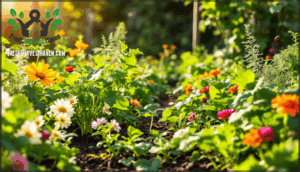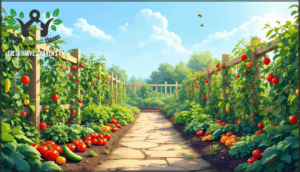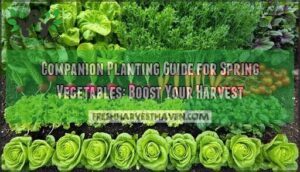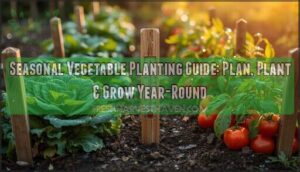This site is supported by our readers. We may earn a commission, at no cost to you, if you purchase through links.
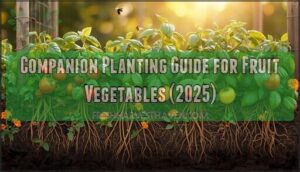 Most gardeners learn companion planting the hard way—after watching a perfect tomato crop wither from an aphid invasion, or discovering their cucumber vines stunted by an incompatible neighbor. Your fruit vegetables are having chemical conversations beneath the soil surface, releasing compounds that either protect their companions or sabotage their growth.
Most gardeners learn companion planting the hard way—after watching a perfect tomato crop wither from an aphid invasion, or discovering their cucumber vines stunted by an incompatible neighbor. Your fruit vegetables are having chemical conversations beneath the soil surface, releasing compounds that either protect their companions or sabotage their growth.
When you pair basil with tomatoes, you’re not just saving garden space; the basil’s volatile oils actively repel hornworms while attracting pollinators that boost fruit set by up to 20%.
Understanding these botanical relationships transforms your garden from a collection of individual plants into a thriving ecosystem where each member contributes to the others’ success, reducing your need for pesticides while increasing both yields and flavor.
Table Of Contents
- Key Takeaways
- Companion Planting Benefits for Fruit Vegetables
- Best Companion Pairings for Fruit Vegetables
- Plants to Avoid Pairing in Your Garden
- Companion Planting Strategies for Pest Control
- Planning and Maintaining a Companion Garden
- Frequently Asked Questions (FAQs)
- What fruits and veggies can be planted together?
- Which vegetables grow well together chart?
- What is the best companion plant for tomatoes?
- Which vegetables should not be planted next to each other?
- Can you plant a fruit tree with a companion plant?
- What is fruit companion planting?
- What is vegetable companion planting?
- How do I plan for companion planting & a successful vegetable garden?
- Which companion plants are best with other plants?
- Why should you plan your vegetable garden out with companion plants?
- Conclusion
Key Takeaways
- Companion planting creates chemical conversations between plants where strategic pairings like basil with tomatoes can boost fruit set by 20% through volatile oils that repel pests and attract pollinators, turning your garden into a self-regulating ecosystem.
- Polyculture gardens with flowering companions yield 32% more fruit by weight while reducing pest populations by 50-75% through natural predators, eliminating the need for chemical pesticides and cutting input costs by thousands per acre.
- Critical incompatible pairings like tomatoes with corn or brassicas can slash yields by 15-40% due to shared pests and allelopathic compounds, making strategic spacing and crop rotation essential for protecting plant health and soil fertility.
- The Three Sisters method—beans fixing nitrogen for corn while corn supports climbing beans and squash suppresses weeds below—demonstrates how indigenous intercropping techniques deliver higher caloric yields per acre than monoculture systems through complementary root systems and resource sharing.
Companion Planting Benefits for Fruit Vegetables
Companion planting transforms your fruit vegetable garden into a thriving ecosystem where plants work together instead of competing. You’ll see better yields, healthier crops, and fewer pest problems when you pair the right plants strategically.
Let’s explore five key benefits that make companion planting worth your attention this season.
Pest Control and Natural Deterrents
Companion planting gives you powerful pest management through natural repellents and biological control. Marigolds slash nematode damage by up to 90%, while basil and thyme cut whitefly and spider mite problems in half when you tuck them near tomatoes. Aromatic herbs like peppermint and garlic disrupt pest behavior—garlic alone reduces spider mites by 42% on tomatoes.
These integrated defense strategies create organic pesticides in living form, deterring garden pests while supporting natural pest control methods that keep your fruit vegetables thriving without chemicals. By implementing a healthy soil ecosystem, gardeners can further boost the effectiveness of their companion planting strategies.
Attracting Beneficial Insects and Pollinators
Beyond deterring pests, you’ll attract powerful allies with pollinator-attracting species. Interplanting marigolds, zinnias, cosmos, and borage boosts pollinator visitation by 45%, while polyculture gardens yield 32% more fruit by weight.
Flowering herbs like basil and dill draw beneficial insects that provide ecosystem services—ladybugs, parasitic wasps, and hoverflies—reducing aphid populations by 50-75%.
Strategic bee attraction through insect-friendly plants creates beneficial habitats, increasing pollinator diversity and naturally strengthening pest control without chemicals. By implementing a healthy garden ecosystem, gardeners can promote biodiversity and reduce the need for pesticides.
Soil Fertility and Plant Health
While pollinators keep your garden buzzing, nitrogen-fixing legumes and deep-rooted companions work beneath the surface to build soil fertility and strengthen plant health from the ground up.
Beans enrich your soil through nitrogen fixation, reducing reliance on fertilizer alternatives while promoting sturdy root development. Deep-rooted plants like comfrey bring up nutrients that shallow feeders can’t reach, improving soil fertility and activating soil microbes.
This natural nutrient cycling adds organic matter, creating thriving conditions that support companion planting benefits throughout your organic gardening system.
Weed Suppression and Resource Optimization
When you let companion plants grow shoulder to shoulder, they naturally crowd out weeds and share resources more efficiently than solo crops ever could. Intercropping sprawling cucumbers beneath upright tomatoes creates a living weed barrier while optimizing soil moisture levels.
This space efficiency through crop diversification means your organic gardening system thrives with less maintenance and better resource sharing among plant companions.
Economic and Environmental Advantages
The financial payoff of companion planting doesn’t just show up in your harvest basket—it transforms your entire growing budget while protecting the planet beneath your feet. Small farms report up to $12,800 additional revenue per acre through strategic companion planting techniques that boost crop yield and reduce chemical inputs.
Companion planting can boost farm revenue by $12,800 per acre while cutting fertilizer costs and protecting soil health naturally
By nurturing soil health and beneficial insects through sustainable gardening practices, you’ll cut cost savings on fertilizers and pesticides while minimizing your environmental impact—organic gardening practices that deliver both ecological and economic wins.
Best Companion Pairings for Fruit Vegetables
Some plant partnerships work like magic in the garden, creating thriving ecosystems where crops protect and support each other. The right companion pairings can transform your fruit vegetable garden from a collection of individual plants into a productive, pest-resistant community.
Here are the most effective combinations you’ll want to try this season.
Tomato, Pepper, and Basil Combinations
If you’ve ever wondered why tomatoes and basil taste better together on your plate and in your garden, it’s because this classic duo creates one of nature’s most effective partnerships for pest control and flavor enhancement. Basil’s aromatic oils mask tomato scent from aphids and hornworms, while its compact growth patterns don’t compete for resources.
Here’s what makes these companion planting combinations work:
- Tomato and basil pairing improves nutrient uptake through complementary root systems
- Pest control happens naturally as basil repels whiteflies and mosquitoes
- Beneficial insects like parasitic wasps are attracted to basil flowers
- Peppers thrive in this companion layout with similar soil temperature needs
- Strategic spacing in your companion planting chart maximizes flavor enhancement
Cucumber, Squash, and Radish Pairings
Radishes act as living pest control in your cucumber and squash beds, breaking the cycle of beetle damage before it ever begins. Their fast germination creates a protective barrier, and dill adds another layer of defense by deterring aphids from cucumbers while attracting predatory insects that patrol your garden synergy.
| Companion | Benefit |
|---|---|
| Radishes + Cucumber | Repels cucumber beetles naturally |
| Dill + Cucumber | Deters aphids, attracts beneficial wasps |
| Nasturtium + Squash | Traps aphids, improves pollination |
| Marigold + Squash | Blocks root nematodes, boosts growth |
Beans, Corn, and The Three Sisters Method
Beans, Corn, and Intercropping create what’s known as The Three Sisters—a Native Farming system you can replicate for powerful Ecosystem Services and Soil Enrichment. Corn provides a living trellis for climbing beans, while beans fix atmospheric nitrogen through Companion Planting synergy. Squash completes the trio with ground-shading foliage that suppresses weeds and retains moisture.
This Intercropping Benefits model delivered higher caloric yields per acre than monoculture planting, supporting roughly 13-15 people per hectare annually. Crop Rotation maintains this balance season after season.
Fruit Trees and Their Ideal Companions
Fruit trees don’t thrive in isolation—they need strategic companions at ground level to control pests, enrich soil, and boost pollination rates. Apple trees benefit from clover and chives that fix soil nutrients, while citrus prefers lavender for companion flowering and pest deterrence.
These tree guilds—the foundation of smart orchard design—create layered ecosystems where fruit tree companion selection directly improves yield and reduces maintenance through beneficial plant combinations.
Flower and Herb Partners for Fruit Crops
Marigolds and nasturtiums aren’t just pretty faces—they’re working companions that transform your fruit crops into pest-resistant powerhouses through targeted scent disruption and predator attraction. Basil and dill serve as herb partners that boost pollination rates while repelling aphids, creating the garden diversity your fruit needs.
Key flower companions for fruit pollinators:
- Marigolds deter nematodes and whiteflies around tomatoes
- Nasturtiums trap aphids away from cucumbers and squash
- Lavender attracts bees to improve fruit set in peppers
These beneficial plant combinations demonstrate true plant compatibility through strategic crop enhancers.
Plants to Avoid Pairing in Your Garden
Not every plant makes a good neighbor, and some combinations can actually hurt your harvest. Certain pairings compete for nutrients, invite shared pests, or even release compounds that stunt growth.
Here’s what to keep separate in your fruit vegetable garden.
Common Incompatible Fruit Vegetables
Pairing certain fruit vegetables together can backfire in ways that hurt both your harvest and your garden’s soil health. Tomatoes and corn, for instance, share the tomato fruit worm as a common pest, and their combined heavy feeding depletes nutrients fast—studies show yield drops of 15–25%.
Tomatoes also clash with brassicas like cauliflower and kale, which release root chemicals that stunt tomato growth by up to 40%.
Meanwhile, melons and cucumbers cross-pollinate easily, creating bitter, unmarketable fruits while attracting shared pests like cucumber beetles.
Smart garden planning through companion planting guides and crop rotation keeps these incompatible pairs apart, protecting plant compatibility and pest control.
Problematic Herb and Flower Pairings
Not all herbs and flowers play well with fruit vegetables—some combinations actually weaken plants, invite pests, or sabotage flavors you’ve worked hard to grow. Here are three problematic pairings to avoid:
- Fennel near tomatoes or peppers – Its allelopathic oils stunt growth by 30%
- Sunflowers with pole beans – They compete for nutrients and attract shared aphids
- Alliums (garlic, onions) with peas – Root chemicals inhibit legume nitrogen fixation
Pest and Disease Risks From Bad Combinations
Beyond choosing the wrong neighbors, you risk turning your garden into a pest magnet or disease hotspot. When tomatoes and corn grow side-by-side, they share the corn earworm—doubling crop vulnerability. Potatoes near tomatoes invite late blight to spread between both crops, causing garden failures.
Poor pairings also weaken beneficial insects and pest predators, leaving plants defenseless.
Smart companion planting strengthens pest control; bad combinations do the opposite, attracting trouble and contaminating soil with pathogens that linger season after season.
Plant Growth Inhibition and Competition
Some plants don’t just attract pests—they actively sabotage each other’s growth, stealing nutrients and releasing chemicals that stunt neighboring crops. Root competition and shade effects create nutrient depletion that weakens your garden neighbors, undermining pest control and weed suppression efforts you’ve carefully planned.
Three Growth Inhibitors to watch for:
- Pole beans near beets — both battle for the same soil space, stunting each other
- Kohlrabi around tomatoes — releases compounds that block tomato development
- Garlic or onion beside peas — alliums halt pea growth through chemical interference
Space optimization through companion planting means respecting each crop’s territory.
Companion Planting Strategies for Pest Control
Protecting your fruit vegetables from pests doesn’t require a chemical arsenal when you use companion planting strategically. The right combinations of herbs, flowers, and diverse crops create natural barriers that confuse or repel destructive insects while inviting beneficial predators into your garden.
Let’s explore four proven strategies that transform your vegetable patch into a self-regulating ecosystem.
Using Aromatic Herbs to Deter Pests
Your garden’s first line of defense might already be sitting in your spice rack—aromatic herbs like basil, rosemary, and thyme don’t just season your meals, they actively confuse and repel the pests that threaten your fruit vegetables.
These fragrant barriers work by masking the scent signals that aphids, whiteflies, and hornworms use to locate their host plants.
Plant basil near your tomatoes and peppers, or establish rosemary borders around your squash to create scented repellents that naturally redirect unwanted visitors without chemicals.
Incorporating Flowers for Natural Defense
Flowers aren’t just decorative—they’re tactical allies that draw in predatory insects like lacewings and hoverflies while repelling the pests that target your fruit vegetables.
Companion blooms create botanical barriers and pollinator attraction zones that strengthen your natural defense system:
- Marigolds near tomatoes release compounds that deter aphids and nematodes
- Nasturtiums act as trap crops, luring pests away from squash and cucumbers
- Cosmos and zinnia invite beneficial insects that patrol for pest outbreaks
This companion planting approach transforms your garden into a self-regulating ecosystem where flower pest control works around the clock.
Promoting Biodiversity to Prevent Outbreaks
Diversified planting reduces major pest outbreaks by up to 50% compared to single-crop systems. When you mix varieties in a polyculture setup, you create natural barriers that disrupt pest movement and support beneficial insects like predatory beetles and parasitic wasps.
| Biodiversity Benefits | Measured Impact |
|---|---|
| Pest population reduction | 84% of cases show improvement |
| Beneficial insect increase | Up to 2× abundance |
| Pesticide use decrease | 65% fewer applications |
| Yield stability improvement | 40% lower annual variation |
This ecosystem services approach transforms your garden into a resilient, self-regulating habitat where pest predators thrive and crop resilience increases naturally—core principles of sustainable gardening and effective pest management through companion planting.
Natural Support and Shade Regulation
Tall plants like sunflowers and trellised tomatoes don’t just grow upward—they create living scaffolding that climbs, shades, and shelters your garden’s more delicate inhabitants. Trellis systems and plant staking establish garden canopies that regulate microclimates, protecting shade-tolerant crops like lettuce from heat stress while maintaining soil health.
Strategic companion planting with natural support structures attracts beneficial insects and optimizes vertical space—turning every layer of your garden into productive real estate.
Planning and Maintaining a Companion Garden
A successful companion garden requires thoughtful planning from the start and consistent care throughout the growing season. Your layout, watering approach, and seasonal adjustments will determine how well your plants support each other over time.
Let’s walk through the essential practices that keep your companion system thriving year after year.
Garden Layout and Plant Spacing Tips
When you’re mapping out your companion garden, think of it like arranging a dinner party—you want plants that thrive together without stepping on each other’s toes (or roots). Here’s how to improve your garden layout:
- Group by growth patterns and water needs – cluster deep-rooted vegetables with shallow-rooted companions for soil optimization
- Position tall plants northward – sunflowers and corn won’t shade your peppers and cucumbers
- Ring perimeters with marigolds – strategic spatial planning creates natural pest barriers
Thoughtful plant grouping transforms your vegetable garden planning into a self-supporting ecosystem.
Crop Rotation and Succession Planting
Crop rotation isn’t just about moving plants around—it’s your secret weapon for soil renewal and farm efficiency. Rotating plant families annually slashed tomato blight by 62% and boosted corn yields up to 30% in three-year systems.
Pair this with succession planting: sow quick crops like radishes every two weeks for continuous harvests. This intercropping strategy optimizes yield, extends your harvest scheduling, and keeps your vegetable gardening thriving all season while improving soil health naturally.
Watering and Soil Management Techniques
Healthy soil and smart watering rhythms form the backbone of any companion garden—even the best plant pairings won’t thrive if the ground beneath them is compacted or parched. Here’s how to get it right:
- Monitor soil moisture weekly—deep-rooted vegetables need infrequent, thorough watering while shallow-rooted crops prefer consistent hydration.
- Install irrigation systems like soaker hoses with timers to support water conservation and prevent overwatering stress.
- Apply 2-3 inch mulch layers to retain moisture, regulate temperature, and boost nutrient cycling through organic matter breakdown.
- Practice crop rotation annually to maintain soil health and prevent nutrient depletion in your garden planning strategy.
These organic gardening fundamentals, combined with proper soil preparation, create the resilient foundation your companion plants need to flourish.
Seasonal Maintenance and Ecosystem Balance
Once your soil and irrigation are dialed in, the real magic happens when you shift your focus to the changing seasons—each one brings its own rhythm of pruning, planting, and pest watching that keeps your garden ecosystem humming along.
Seasonal pruning clears spent foliage and encourages soil renewal, while biodiversity management—rotating crops and inviting beneficial insects—builds climate resilience.
This ongoing organic gardening approach strengthens ecosystem services like natural pest control, guaranteeing your companion planting system stays balanced and productive year-round.
Frequently Asked Questions (FAQs)
What fruits and veggies can be planted together?
Tomatoes thrive alongside basil, while cucumbers pair well with radishes and dill.
Beans complement corn beautifully, and squash grows happily with nasturtiums.
Fruit trees benefit from clover, garlic, and aromatic herbs planted beneath their canopy.
Which vegetables grow well together chart?
Pairing compatible vegetables starts with understanding Garden Mapping and Crop Planning. A Companion Planting Chart reveals that tomatoes thrive with basil, beans enrich corn, and cucumbers benefit from radish companions—smart Vegetable Pairing that naturally aids Intercropping for pest control.
What is the best companion plant for tomatoes?
Basil stands out as the top companion for tomatoes, deterring pests while improving fruit yield and flavor.
Marigolds also work well, repelling harmful insects and attracting beneficial ones that support healthier growth.
Which vegetables should not be planted next to each other?
Avoid pairing tomatoes with corn or potatoes—they share common pests and diseases.
Keep pole beans away from beets, as they inhibit each other’s growth.
Don’t plant garlic near peas; it stunts development.
Can you plant a fruit tree with a companion plant?
Yes, you can plant fruit trees with companion plants. Smart companion selection bolsters tree health through improved soil, pest deterrence, and pollinator attraction.
Apple trees thrive with chives and garlic, while citrus prefers lavender and thyme—these pairings boost garden diversity naturally.
What is fruit companion planting?
Imagine this: it’s like matchmaking for your garden, but instead of swiping right, you’re strategically placing plants.
Fruit companion planting pairs fruiting crops with complementary species that improve garden diversity, plant synergy, and crop resilience through natural pest control and ecological balance.
What is vegetable companion planting?
Vegetable companion planting pairs garden vegetables strategically to boost crop resilience and soil harmony.
You’ll create plant diversity that attracts beneficial insects and pest predators while improving eco balance through natural garden symbiosis and thoughtful vegetable pairings.
How do I plan for companion planting & a successful vegetable garden?
Imagine your garden as a living tapestry where each thread strengthens the whole. Start with soil preparation—test pH and enrich with compost—then map out crop selection based on companion gardening tips and space optimization, grouping vegetable pairings by water needs and growth habits for thriving seasonal care.
Which companion plants are best with other plants?
Strong plant pairings include tomatoes with basil for pest deterrents, beans with corn for soil enrichment, and marigolds with fruit trees for pollinator attraction.
These companion planting strategies create garden diversity, mutual benefits, and ecosystem balance while supporting beneficial insects.
Why should you plan your vegetable garden out with companion plants?
Think of your garden as a living puzzle where each piece needs the right neighbor. Planning with companion planting creates plant symbiosis, boosting crop resilience through ecosystem balance and nutrient cycling while attracting beneficial insects.
Conclusion
You might worry that companion planting is too complex for beginners, but start with just three proven pairings—basil with tomatoes, marigolds with peppers, radishes with cucumbers—and you’ll witness the difference within weeks.
This companion planting guide for fruit vegetables isn’t about memorizing charts; it’s about observing how your plants communicate and support each other.
Once you see healthier foliage, fewer pests, and heavier harvests from these strategic partnerships, you’ll naturally expand your combinations with confidence.
- https://www.burpee.com/blog/companion-planting-guide.html?srsltid=AfmBOooEZK_WSEcGP76Y22RqmeZMzGy89eWyt7iMlH2ZMB8xA9pCAu4e
- https://www.quora.com/In-planning-a-vegetable-garden-what-are-the-most-compatible-vegetables-to-grow-together-or-doesn-t-it-matter-which-ones-grow-side-by-side
- https://gilmour.com/companion-planting-chart-guide
- https://www.thespruce.com/companion-planting-with-chart-5025124
- https://www.thrivelot.com/resources/companion-planting-guide-10-plant-pairs-2024


